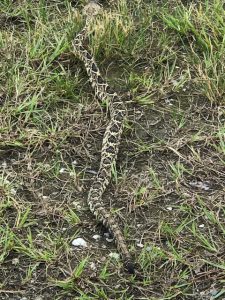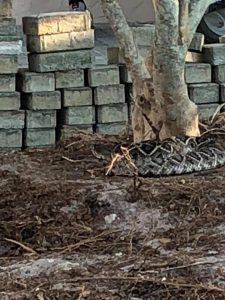In the past week, three eastern diamondback rattlesnakes were encountered near the Ft. Pickens area on Pensacola Beach. The first was at a condominium unit near the park gate where construction work was occurring, the second was found swimming in the surf of the Gulf of Mexico within the national seashore, and the third was in the national seashore’s campground. This is an animal we rarely encounter on our barrier islands – but that is the keyword… encounter… they are there, but tend to avoid us.
Report on rattlesnake in Gulf surf –
The eastern diamondback rattlesnakes (Crotalus adamanteus) is the largest venomous snake in the United States. An average snake will reach six feet and five pounds, but they can reach eight feet and up to 15 pounds. Because of their large bodies, they tend to move slow and do not often try to escape when approached by humans. Rather, they lie still and quite hoping to be missed. If they do feel you have come to close, they will give their signature rattle as a warning – though this does not always happen. If they are considering the idea of striking – they will raise their head in the classic “S” formation. Know that their strike range is 2/3 their body length – larger than many other native snakes – so a four foot snake could have a three foot strike range. Give these snakes plenty of clearance.
Eastern diamondback rattlesnakes prefer dry sandy habitats, though they are also found in pine flatwoods (such as Naval Live Oaks north of highway 98 in Gulf Breeze). They are quite common in the upland sandhills of longleaf pine forests. They spend the day in tree stump holes and gopher burrows and hunt small mammals and birds in the evenings. They are particular fond of rabbits. The dunes of our barrier islands are very similar to the sandhills of the pine forest further north. They are actually good swimmers and saltwater is not a barrier – distance is. They have been seen numerous times swimming from Gulf to Pensacola Beach or the opposite. Again, they tend to avoid encounters with humans and are not often found on lawns etc.
Diamondbacks give birth to live young around August. The females will find a dark-cool location to den and give birth several young. Anywhere from four to 32 offspring have been reported. The female remains with the young for about 10 days until they have their first molt (skin shedding) and then she leaves them to their fate.
So what’s up with three encounters in a relatively small location within one week?
My first inclination is two possibilities – maybe a combination of the two.
- We have had a lot of rain this year – and then T.S. Gordon came through. Snakes like to be on high dry ground as much as anyone else and they tend to move closer to human habitats because they are built on higher ground.
- Breeding season for eastern diamondbacks is late summer early fall. This time of year, the males are on the move seeking interested females – so they are encountered more.
As far as finding one in the surf of the Gulf of Mexico. I am not sure. I have never seen this and the newspaper account suggested it was not doing well when found. Again, I have seen plenty swimming the Intracoastal but this is a first for the Gulf. I would say it had wondered the wrong way.
They are actually fascinating animals and are not a threat unless you approach too close. Give them room and feel lucky if you get to see one.
References
Eastern Diamondback Rattlesnake. Natural History. Center for Biological Diversity. https://www.biologicaldiversity.org/species/reptiles/eastern_diamondback_rattlesnake/natural_history.html.
Krysko, Kenneth L., and F. Wayne King. 2014. Online Guide to the Snakes of Florida. Florida Museum of Natural History, University of Florida, Gainesville, FL, USA. [Online: September 2014] Available at: http://www.flmnh.ufl.edu/herpetology.
https://www.floridamuseum.ufl.edu/herpetology/fl-snakes/list/crotalus-adamanteus.
- Our Environment: Part 10 – Improving Agriculture - June 20, 2025
- Marine Creatures of the Northern Gulf – Snails and Slugs - June 20, 2025
- Our Environment: Part 9 – Agriculture Challenges - June 6, 2025


